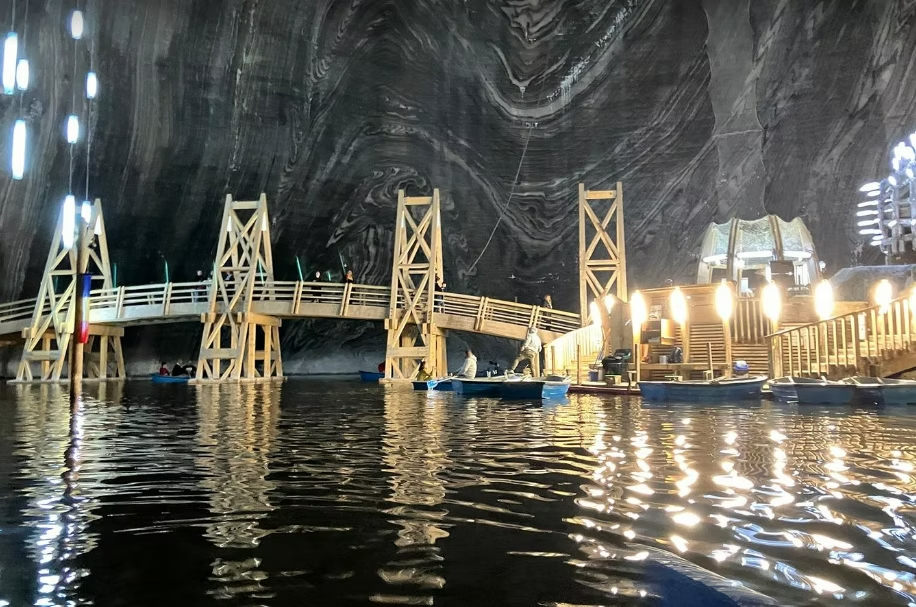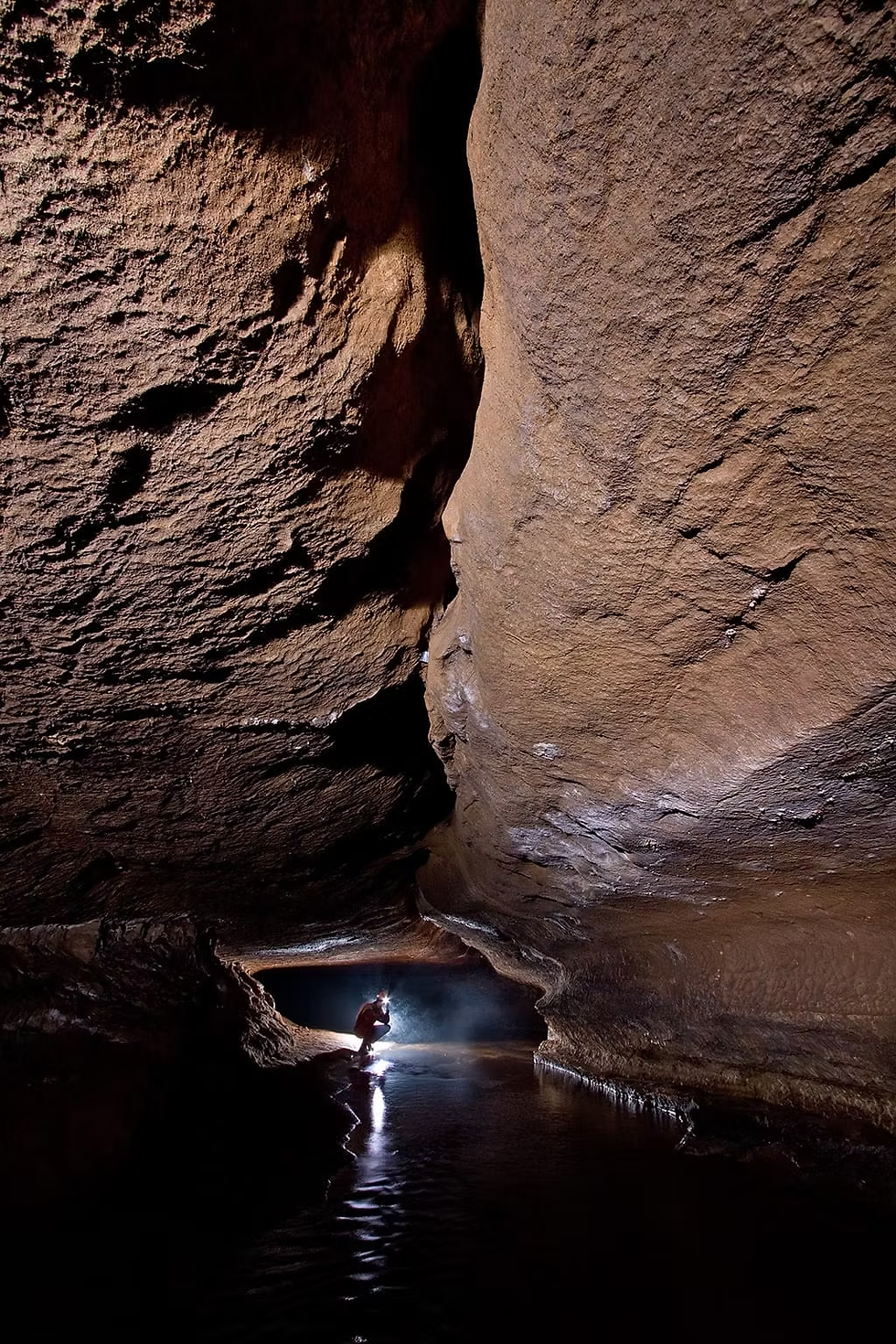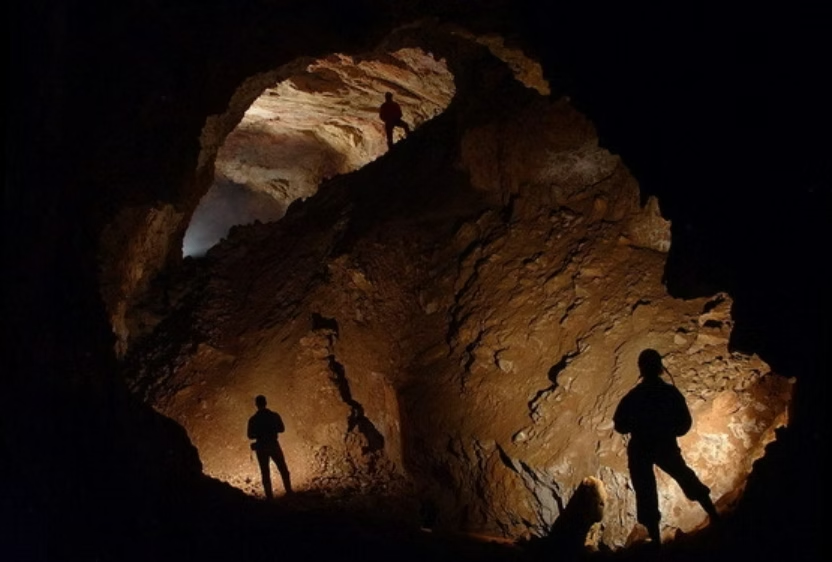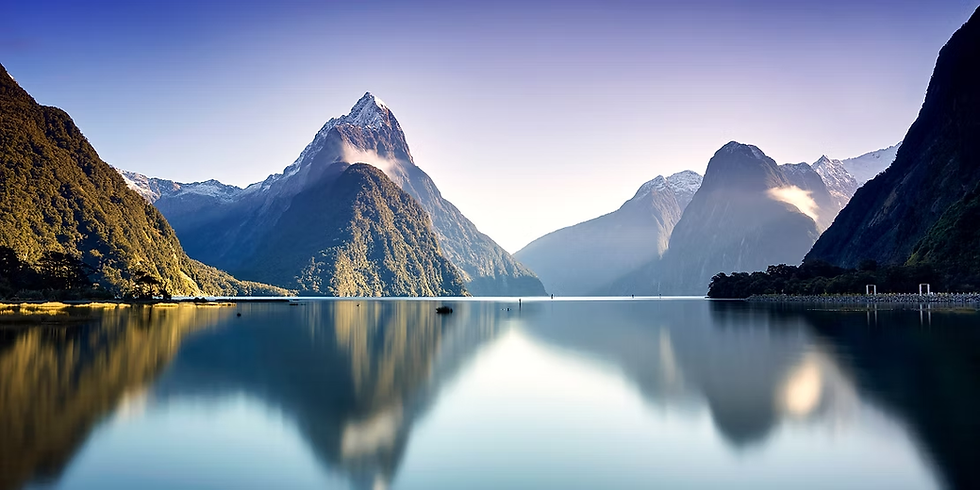JOURNAL FROM THE DEPTHS – THE LIMESTONE HEART OF ROMANIA
- angelogeorge988
- Jul 6
- 12 min read
In the summer of 1997, I had the rare privilege of becoming—if only for a few days—a fully fledged speleologist. Armed with a video camera and boundless curiosity, I embarked on an underground adventure, filming for Europa Nova Television in Bucharest as part of an extensive Sustainable Development Program focused on Romania’s karst landscapes. This was more than a simple report—it was an initiation into the mysteries of limestone, shared with an international team of speleologists and explorers from France, Belgium, and Switzerland. These were people accustomed to venturing where light cannot reach, working with the earth’s hidden map, and conversing with the cold silence of the abyss.

The expedition begins symbolically right in front of the Ministry of Tourism in Bucharest—a kind of departure gate to a world absent from conventional brochures, yet home to one of the country’s greatest natural treasures: the Wind Cave (Peștera Vântului), the longest cave in Romania. Hidden within the rocky embrace of the Pădurea Craiului Mountains, in the heart of the Western Carpathians, this subterranean marvel stretches over 52 kilometers of mapped galleries, forming a labyrinthine system that rivals an underground city. The Wind Cave is a true cathedral of stone and darkness. Access begins near the village of Șuncuiuș, in Bihor County—an area that also offers a wealth of attractions for travelers: breathtaking hikes, climbing routes, and a host of other caves open to the public, such as Ungurului Cave and Bătrânului Cave.

“The Wind,” as it’s known to those familiar with its secrets, is a cave for the initiated. Here, I descend not only through geological layers, but into the depths of my own being. I don’t just see—I feel: the stratified dampness in the air, the echo of my footsteps on cold clay, the murmur of the air that at times seems to whisper stories thousands of years old. It’s a place where time stretches and warps, and orientation becomes an exercise in surrender and clarity. For me, it feels as though I’m entering a living organism, with limestone veins and hidden hearts shaped like vast chambers. I film underground waterfalls, formations as delicate as lace, and passages so narrow that only courage can carry you forward. It is a journey of initiation, but also an act of humility before nature. This is how my story with the depths begins—not as a mere tourist, but as a witness and scribe of an unseen realm, where the beam of a headlamp is the only possible sun, and the map is drawn step by step, with rope and patience.

Through Romania, Along the Thread of a Living Map
Our journey into the depths of the Pădurea Craiului Mountains begins at the surface, along the European route E81—a kind of vertebral column that runs through Romania from south to north, cutting through the geographical and historical heart of the country. We cover 553 kilometers in 12 hours—a stretch of time expanded by stories and punctuated with brief stops, lingering gazes, and places that demand to be told. I am the guide of this expedition—not merely because I hold the map in my hands, but because geography has always been my second language, and history, my inner alphabet. So, as the minibus moves forward, I weave a narrative thread from all the visible and invisible strands of the road.

We leave Bucharest early, leaving behind the city’s bustle, and roll into the slumbering plains of Muntenia, then across the Olt River into the hilly heart of Wallachia. In Pitești—a city with the scent of industrial chrysanthemums—we make our first stop, before crossing the Olt Gorge, a passage like a tunnel of stone and foliage, a gateway between worlds.

Râmnicu Vâlcea is a charming, rustic town, nestled among gentle hills and forests scented with linden blossoms and damp earth. The old houses, with their wooden porches and grapevines clinging to the eaves, seem to whisper stories from another time. The waters of the Olt River flow calmly nearby, like a quiet heart beating in tune with the unhurried rhythm of the place. On summer mornings, mists descend softly over the town, and the bells of ancient churches weave time together with prayer. It is a place where past and present join hands in silence, beneath a sky filled with clouds like forgotten wings.

Farther along, Sibiu greets us like a silent citadel, with Gothic spires and rooftops that seem to watch you. Sibiu rivals the beauty of the most stunning cities I’ve visited in Europe—a jewel of Transylvania, with its cobbled streets that feel as though they were sketched by a painter in love with detail. Ancient towers keep watch over the russet rooftops, and the “eyes” of the old town’s houses gaze back with gentle curiosity. The Great Square pulses with life and history, and in the evening, the glow of lanterns melts the walls into a blend of gold and nostalgia. Here, time is in no hurry—only the strolls, the memories, and the dreamlike footsteps move forward.

Alba Iulia, the City of the Union and an ancient stronghold of the Romanian people, is a place steeped in soul and history, where every step echoes in the footsteps of our ancestors. Here, the past breathes through the massive walls of the Alba Carolina Citadel—through its bastions, sculpted gates, and pathways that lead to the heart of a national story. It is a place where one could wander for weeks without exhausting its treasures—from the Cathedral of the Reunification and the Union Hall to the ceremonial changing of the guard, rich in pageantry and solemnity. Beneath every stone seems to slumber a legend, and the air carries the echo of oaths sworn to dignity and freedom.

Turda appears to us like an open window into the underground: if the Wind Cave awaits us hidden in the mountains, here, the Salt Mine offers a prelude—a first symbolic descent into the silent world of the depths. The Turda Salt Mine stands as a sentinel at the gates of the past, reminding us that a journey here is a descent into the bowels of the earth and of history. Each step downward carries us through salt-carved galleries, meticulously shaped by generations, where time itself seems to have paused. Beyond its therapeutic function, the Salt Mine is a true subterranean cathedral—a place of stillness, wonder, and reflection, nestled in the heart of Transylvania.

Next comes Cluj-Napoca, a cultural and academic capital, where we spend the night, preparing for the day ahead—the day we enter the living darkness of Romania’s longest cave. Along the way, we come to understand that a map is not just a sheet of paper, but a poem of the land, and Romania—a never-ending text of hills, rivers, and cities that reveal their stories, if you’re willing to listen.

At the Foot of Pădurea Craiului – The Roots of the Crișul Repede
Șuncuiuș. A name that echoes with stillness, with old wood and flowing water. Nestled at the foot of the Pădurea Craiului Mountains, the village seems to stand watch—silent and patient—over the middle course of the Crișul Repede River, which runs through it like a living artery, shaping not only its landscape but its very purpose. The road here is a passage from turmoil to retreat. As we move downstream, the Criș gathers within it the stories of springs and mountain brooks, each bearing its own name, like chapters in a novel of stone and water: the Spring beneath the Raven’s Rock, secretive and cold; then the Valley of the Groși, with its shadowed forests; the Valley of Mughiuruș, Misid, Țarinii, and Izbândiș—each adding a drop of strength and memory.

In the end, the Făget Valley pours its waters like a melancholic epilogue, shaped by the whims of the sky—for the flow of all these tributaries shifts with the rains, the melting snows, and the seasons that slip across the mountain slopes.

For speleologists, geographers, and dream-filled travelers, these waters are not merely hydrological tributaries—they are the invisible threads of a karstic tapestry, feeding the underground, filling galleries, eroding limestone, and giving birth to caves. In this light, Șuncuiuș becomes more than a point on the map—it becomes a gateway between two worlds: the one above, where light dances across the waves, and the one below, where the Wind Cave lies, breathing its cold and eternal breath.

The Evening Before the Descent – Trout, Legends, and Subterranean Promises
After long hours on the road and the geographic fascination of the journey, we finally arrive in Șuncuiuș and settle into a charming guesthouse, nestled in the lush greenery of the Pădurea Craiului Mountains. The air is clean, damp, and cool—a sign that the mountain breathes nearby, and the Crișul Repede murmurs not far off, like a promise waiting to be fulfilled.

We spend the evening at an exceptional trout farm in Șoimuș, tucked between hills and pampered by the cold waters of the valley. There, beneath a canopy of stars that seems to mirror the subterranean constellations of the cave awaiting us, we are welcomed by a local guide—his voice calm, his eyes carrying the weight of things seen but not spoken. As freshly caught trout sizzles in the pan and steam mingles with the scent of damp wood, the guide begins to tell us about the places we’ll descend into the next day. Not just technical details—but legends. Of the wind that escapes from the rock, not merely air, but the breath of an underworld. Of chambers with strange names, where some say the echo of footsteps still lingers—footsteps of those who never returned. And of the underground waters that flow in silence, following paths no map could ever contain.

Each story feels like it opens a door. We glance at one another with a restrained eagerness. We begin to feel the thrill of initiation—not as tourists, but as those who have been called. Night falls slowly, and beneath the sky above and the earth below, we sense that we are standing precisely between two worlds—on the threshold between the real and the mysterious. The next day, we descend. Not just into a cave. But into another way of being.

When the Earth Breathes
We stand before the entrance. This is not a cave in the touristic sense—no railings, no amber lights—but a metal hatch, rusted at the edges, embedded in the ground like an industrial trapdoor. It looks more like a manhole in a forgotten city than the gateway to a subterranean temple. Everything is stark, unadorned, functional—and precisely for that reason, unsettling. The speleologists—people with steady movements and silent eyes—hand us thick suits in jarring colors: orange, red, phosphorescent yellow—shades that seem to scream against the darkness awaiting us. We’re given carbide lamps, which we attach with uncertain gestures to our protective helmets, and each lit flame illuminates a fragment of the unknown. The smell of carbide is sharp, mineral, unearthly—a blend of wet stone, heated metal, and the underworld. It seems to carve into your mind a memory that isn’t yours, an ancient premonition of the deep. Tension gathers in the chest, but paradoxically, as we draw closer to the entrance, it begins to dissolve—the place asserts its presence with the hush of a catacomb.

The descent begins. Before us—a narrow, slippery ladder that seems to vanish into the belly of the mountain. I prepare to step down, but just then, a powerful gust of wind bursts from the abyss—a near-violent blast that rips the video camera from my hands with the force of a living creature, furious that we’ve opened its door. Instinctively, I grip the edge of the hatch.
The air rushing out is cold, swirling, with a prolonged hiss—like the breath of another world. It doesn’t feel like we’re entering a cave, but rather approaching the eye of a cyclone, the mouth of a storm trapped in stone. I take a deep breath. The last lungful of surface air. From this point on, there is no natural light, no horizon, no sky. Only darkness, rock, and the sound of our footsteps in the unknown. I descend. Slowly. We begin.

Beauty That Knows No Light
We step—or rather crawl—into absolute darkness. This is no metaphor. It is a perfect black, a total absence of any light source, so complete that even the flames of our carbide lamps seem timid, like frightened fireflies. The first part of the route is low, a damp and narrow gallery that forces us to move almost on all fours, through a viscous, gleaming mud with a texture somewhere between clay and raw silk. I see it glinting in the yellow flame’s glow, but I don’t feel it—the protective suit clings like a second skin, shielding me from discomfort and amplifying the strange charm of this journey. The mud becomes scenery, not obstacle—a liquid mirror of the earth itself. We continue through a succession of chambers and galleries, each with its own personality, its own shapes, shadows, and silences. We cannot count them, cannot fully comprehend them—we simply pass through, with the wonder of visitors who know they are seeing only fragments of a vast subterranean continent. We cover just 200 meters, yet already we feel we’ve entered another dimension. And still, the Wind Cave stretches on for 52 kilometers of mapped galleries—a whole world hidden in the bowels of Romania, not yet fully explored even by the most seasoned speleologists. We are merely fleeting footsteps in the heart of a limestone eternity. And all we can do is look, fall silent, and move forward—one meter, one miracle at a time.

The Stone Cathedral and the Mirrors of the Deep
Here is where the mystery begins. The Great Hall opens like a Gothic cathedral carved by time, with soaring vaults that seem to breathe on their own and walls that still hold the echo of the very first footsteps. A cold current sweeps through the space like an ancient voice—the breath of the cave, its hidden pulse. It is a heart that beats unseen. The silence in the Hall of Lakes drowns in cold, clear waters—subterranean lakes that reflect not the sky, but thoughts. Mirrors of the earth. In them, the beams of our headlamps soften, and our shadows dissolve into liquid circles. The water flows slowly, almost ritually, whispering the names of those who have passed through.

The Endless Ritual of Water and the Solitary Column
This is the Active Chamber, where stone does not sleep. Here, the underground river works tirelessly, polishing the limestone drop by drop, millennium by millennium. The sound of flowing water is deep and soothing—like a prayer in a language you can only understand with a part of your soul. After about twenty meters, the gallery widens, and before us appears the Torpedo—an imposing limestone formation, vertical and strangely perfect, sculpted by time and water. It possesses a raw, almost wild beauty, like a relic from a world untouched by human eyes. My breath catches—not from effort or fear, but from the unearthly beauty of this stone colossus, faintly glistening with droplets that trickle from its tip. Water drips rhythmically from its peak, like a geological metronome, reminding us that it is the silent artist who has shaped everything here over thousands upon thousands of years, drop by drop. It is a perfect stalagmite, vertical, like a sacred column in the midst of silence. Anchored in the heart of the cave, it feels like a relic left behind by another civilisation—one that never needed light. The water dripping from the ceiling blesses it with patience, like an artist who is never in a hurry.

The Chamber of Petrified Dreams and the Mechanism of the Underworld
We enter the Hall of Wonders, where stone dreams. Translucent draperies hang from the ceiling like folds of mother-of-pearl, columns rise from the earth like frozen prayers, and stalactites resemble the earth’s tears—suspended just before falling. This is a place where beauty is not meant for the eyes, but for awe. The Labyrinth Hall is a space that does not reveal itself all at once—it allows itself to be deciphered step by step. A tangle of galleries, a web of paths that twist and coil like a mind in the midst of dreaming. It is easy to lose yourself here—not just your body, but your thoughts as well. This is the zone where the earth writes its secret geometry.

The Unwritten Realm
What follows is the deep—where the galleries have yet to be mapped. The unknown, unspoken, unexplored space. It is the place where stone still keeps silent, waiting for the footsteps of the next dreamer. The return unfolds like a weathered journal page, filled with echoes and flickering lights dancing among the leaves. I walk once more along familiar paths, as if stepping back into the pages of an old adventure book—a Cireșarii tale, where Tic, Victor, Ursu, and Lucia set off again toward the mysteries of the Black Cave. Every bend bears the imprint of time and the whispers of their footsteps, and I feel like the director of a silent film, their shadows drawn across the forest walls. My thoughts gather in luminous spirals, like sunbeams filtered through the branches—invisible guides through the labyrinth of my mind. Every breath of wind carries the scent of adventure and the promise of untold stories. I feel myself swaying between present and past, between reality and fairytale, and it seems the entire forest breathes in rhythm with my heart. It is a journey that ends only to begin again—like an open book, waiting to be leafed through once more, and yet again.

The film I created was lost in the shadows of my departure to New Zealand—toward a new life, unknown and full of promise. What remains is only a pale copy, a shadow of memory—a voiceless VHS tape, stripped of whispers, which I revived with ambient music, like a murmur of the cave’s secrets. This fragile reprise can be found at the end of this article, accompanied by modern, luminous images from the heart of the cave, where darkness becomes a stage and mystery comes to life. In a future episode of this journal, I will take you with me to the Citadels of Ponor and the Bears’ Cave—other hidden sanctuaries in the same geographic heart, where time seems to pause and listen. Until then, I invite you to read and to dream with open eyes of these subterranean worlds—silent temples where sound’s echo reverberates like a caress, embracing every shadowed corner, every secret gallery, every soul that steps into the depths.




Comments